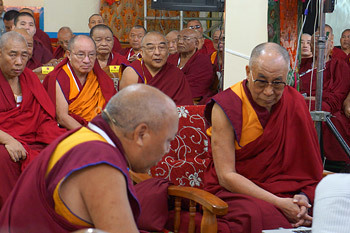Drepung Lachi, Mundgod, Karnataka, India — January 20, 2013
At the foot of the majestic hills of Mundgod, where ancient Tibetan traditions are preserved with reverence, a unique gathering unfolded within the sacred walls of Drepung Lachi Monastery. For several days, monastics, scholars, and scientists from around the world have come together to explore the intersection of science and Buddhist philosophy. Presiding over these sessions with thoughtful attention has been His Holiness the Dalai Lama, who has taken part in every discussion with his characteristic curiosity and warmth.
Today’s topic: the nature of consciousness—a subject that continues to challenge scientists and philosophers alike, yet sits at the heart of Buddhist inquiry. The morning began with a presentation by Christof Koch, a leading neuroscientist in the study of consciousness, whose lineage of thought he traced through Plato, Descartes, Darwin, and his mentor, Francis Crick.
“We take a physicalist approach,” Christof explained. “Our theories must be testable. Quantum mechanics or the periodic table, for example, tell us little about consciousness.”
Drawing a sharp contrast between inanimate objects like radios and the human brain, he described what scientists call the “explanatory gap”—the mystery of why certain biological systems give rise to subjective experience. Christof’s guiding principle echoes Galileo: “Measure what is measurable, and make measurable what is not.”
He emphasized that while complex biological systems such as the immune system and liver function without consciousness, the brain somehow produces it. His Holiness gently asked where, then, consciousness begins—at what level of complexity? Christof admitted that science can only speculate: “All mammals have consciousness. Perhaps even bees.” The question, he added, is whether consciousness always requires a brain. So far, we just don’t know.
“We love machines,” Christof said. “But can we build one that knows what it feels like to be a machine? That’s the dream—because it might help us measure consciousness.”
A Buddhist Lens on Consciousness
Following Christof’s scientific perspective, Mathieu Ricard—a Buddhist monk with a background in molecular biology—offered insights from the Buddhist tradition.
He began by recalling the Buddha’s approach: not dogma, but method. “The Buddha didn’t declare, ‘This is the truth.’ He said, ‘This is the path I walked—try it for yourself.’”
Mathieu emphasized that, in Buddhism, consciousness is not incidental—it is the foundation of experience. “One moment of consciousness gives rise to the next. We see thoughts, memories, awareness—all within the mind,” he said.
“In Richie’s lab, what did they find? They found that I have a brain,” he joked, lightening the tone.
Unlike science, which relies on external instruments, Buddhist practitioners explore consciousness through introspection—the “telescope of the mind.” This method, while subjective, is consistent with the Buddhist understanding that consciousness is the primary reality through which all experience is filtered. Without consciousness, he asked, “Who or what would be asking the question?”
Mathieu also touched on intriguing phenomena that challenge conventional science: past-life recollections, near-death experiences, and instances of mind-to-mind communication. He cited the work of Dr. Ian Stevenson, who documented children with verified memories of past lives, and he shared stories from his own encounters with individuals who recalled previous existences in vivid detail.
His Holiness joined in, noting his own observations of clairvoyance among highly trained monks. He recalled once telling his tutor, Ling Rinpoche, that he seemed to have moments of clear insight. The reply? “Yes, sometimes that happens.” His Holiness also referenced his own experience of post-death meditation, having remained in a state of meditative absorption for 13 days after the physical body ceased.
Subtle Energy and the Subtle Mind
The discussion grew deeper as participants explored the relationship between consciousness and subtle energy. His Holiness explained that, in Buddhist philosophy, the subtle mind is the fundamental basis of all consciousness, with the body as its cooperative—but not substantial—cause.
One question raised was how information is carried within this subtle framework. His Holiness responded with a poetic metaphor:
“The subtle energy is like a blind man with strong legs, and the mind is like a sighted man with no mobility. The mind rides the blind man. Together, they move.”
Information, he explained, is stored in the form of imprints and traces left on the mind by our actions.
Bridging East and West
The afternoon session brought more thought-provoking perspectives. Indian scholar Rajesh Kasturirangan referenced Gandhi, who once said he wanted to keep all his windows open—but not be blown off his feet. Rajesh proposed that computational methods could help map out consciousness in a structured and accessible way.
French philosopher Michel Bitbol addressed the deep question of whether consciousness has a material basis. Quoting one of Christof’s own works—“Subjectivity is too radically different to be an emergent phenomenon”—he challenged the prevailing materialist view. He also reminded the group of a major limitation in scientific inquiry:
“The seer does not see itself. Once we take the objective view, the knower is excluded from the frame.”
He cited Japanese philosopher Kitaro, who echoed this sentiment, and praised Francisco Varela (a co-founder of the Mind & Life dialogues) for advocating a method that integrates both objective observation and subjective awareness.
This led to a fascinating discussion with Richie Davidson, who emphasized that accurate subjective reporting requires great self-awareness and honesty. Michel agreed, but suggested new interview techniques that could help document such experiences with more consistency.
A Meeting of Minds
Closing the day’s rich dialogue, physicist and moderator Arthur Zajonc reflected,
“I hope we come to a point where we can be agnostic about the substrate of consciousness.”
His Holiness smiled warmly and offered his final thought:
“This is wonderful. Real discussion. I have nothing special to add, but I truly enjoyed this frank exchange. If everyone simply agrees and nods along, we don’t grow. Thank you.”
And with that, the day ended—not with final answers, but with shared wonder, deeper questions, and a renewed respect for both scientific inquiry and contemplative tradition.

